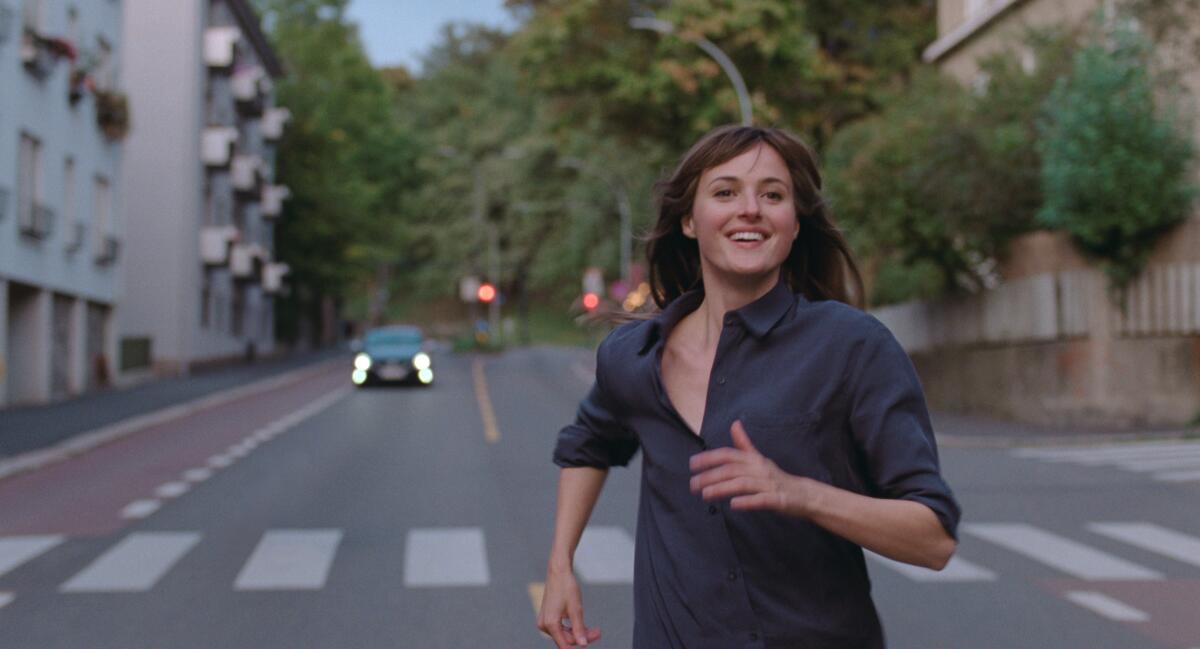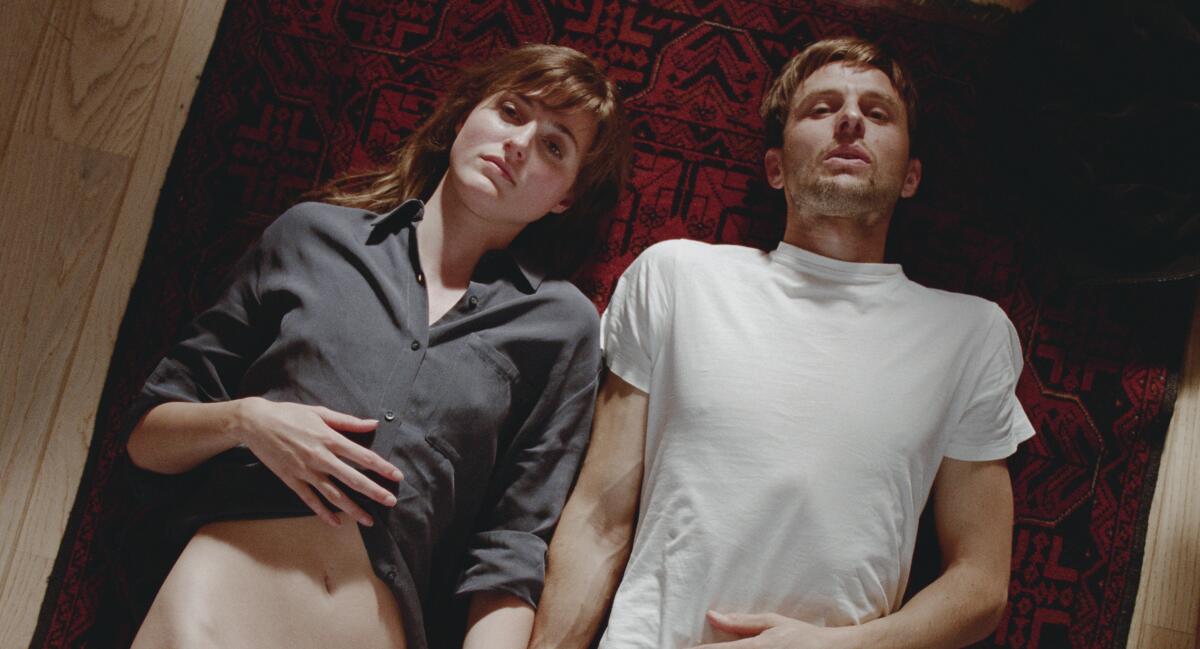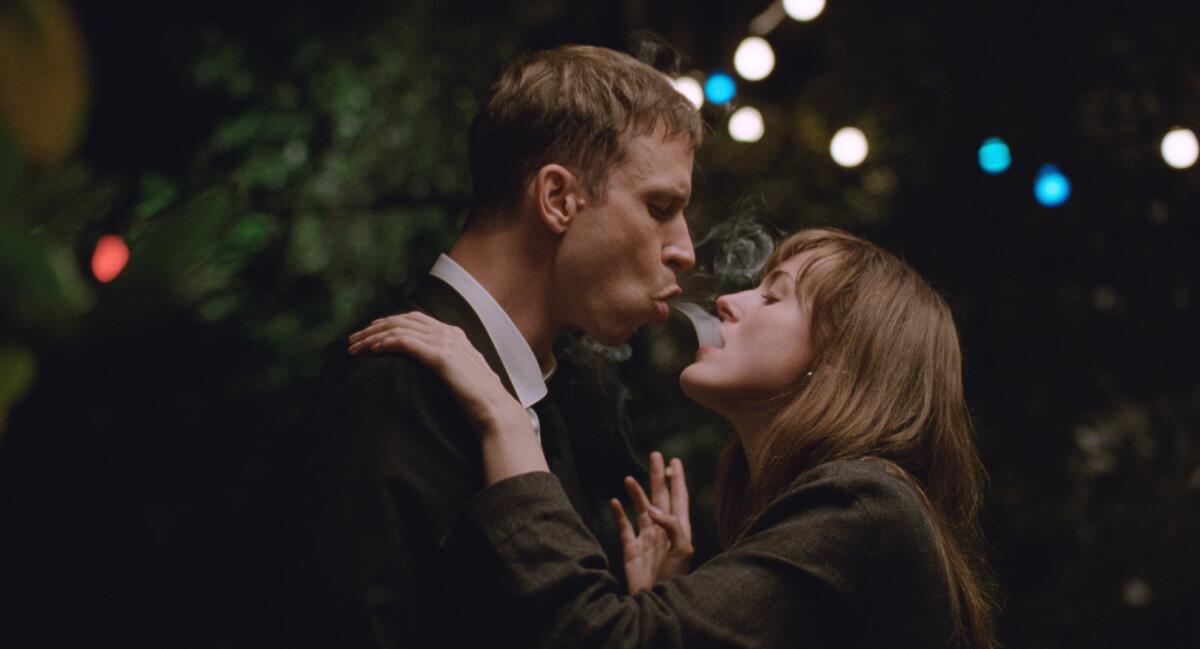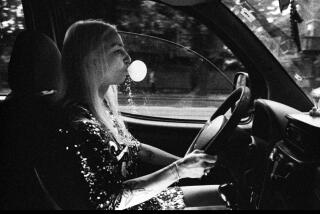Review: ‘The Worst Person in the World’ has one of the best movie heroines in ages

The Times is committed to reviewing theatrical film releases during the COVID-19 pandemic. Because moviegoing carries risks during this time, we remind readers to follow health and safety guidelines as outlined by the Centers for Disease Control and Prevention and local health officials.
In the opening moments of “The Worst Person in the World,” a funny, melancholy dazzler from Norwegian writer-director Joachim Trier, time rushes by in a disorienting blur. Julie (a revelatory Renate Reinsve), the story’s chronically restless late-20-something heroine, switches career paths and hair colors with dizzying indecision: medicine, psychology and photography; blond, pink and brown. She cycles through men with similar impatience, ditching one boyfriend and flirting with another before falling in love with Aksel (Anders Danielsen Lie), a soulful comic-book artist in his early 40s. These and other details are zippily rattled off by a narrator who just about keeps pace with Julie’s every whimsical course correction. Life’s possibilities seem truly limitless, even if time — as Trier, with his finger on the fast-forward button, reminds us — is anything but.
This grabber of a sequence, the first of the story’s 14 parts (prologue, 12 chapters, epilogue), presents Julie to us with pride, affection and perhaps a hint of exasperation. For admirers of Trier and his regular co-writer, Eskil Vogt, the montage may also strike a familiar chord: His 2006 debut feature, “Reprise,” began with a similar frenzy of exposition as it hurled us into the lives of two young male writers, both of them just as upbeat as Julie and just as unprepared for the turmoil ahead. In that picture and others — a piercing drama of addiction (“Oslo, August 31st”), followed by two less successful studies of grief (“Louder Than Bombs”) and supernaturally charged desire (“Thelma”) — the emotional and existential travails of young people have remained Trier’s creative lifeblood. His empathy for them remains undimmed, even if, at 47, he can’t help but survey a fresh-faced millennial like Julie from an older remove.
Some would say older and wiser, though I’m not sure Trier would. He has never been one to assume that wisdom comes with age; the parents and mentor figures in his movies, in particular, run the gamut from irresponsibly selfish to dangerously overbearing. Julie’s own parents could certainly be worse; she has a close relationship with her loving mother and a tougher one with her distant, recently remarried father (Vidar Sandem). You may wonder if that combo of maternal indulgence and paternal neglect accounts to some degree for Julie’s innate restlessness, her wariness of male authority and her ambivalence about having children of her own.

Maybe it does and maybe it doesn’t. While every chapter in this playfully structured movie reveals some crucial detail about who Julie is (and who she might become), Trier isn’t one to diagram his characters so neatly. As an artist he’s more instinctual than analytical, something that could be said of Julie as well. The most mercurial movie heroine in many a moon — rivaled only by “Licorice Pizza’s” Alana Kane, another young woman allowed to be her gloriously drifty, unruly, undetermined self — Julie is nothing if not a creature of impulse, someone who finds her equilibrium by keeping everyone off-balance. And Reinsve’s performance, which earned her a recent BAFTA nomination as well as an acting prize at last year’s Cannes Film Festival, is the movie’s thrilling center of gravity, registering every shift in mood and perspective with impish wit, tremulous feeling and a quicksilver fluidity that’s heightened by the alertness and mobility of Kasper Tuxen’s cinematography.
Julie’s love for Aksel flies in the face of — and indeed, may have been spurred by — his calm, reasonable insistence that their age difference makes them incompatible. And while Aksel may have a point, the intensity of their attraction forges its own unignorable logic. Before long they’re living together, a step toward commitment that brings frustrations both expected and unexpected. A getaway with Aksel’s married-with-children friends spurs the latest of many tough conversations about whether or not they should start a family. Aksel’s professional success — he’s penned a series of popular, sometimes controversial graphic novels — often leaves Julie on the outside looking in, even as she approaches her 30th birthday with vague creative aspirations of her own.
The end of their relationship happens by accident and feels like fate. Leaving Aksel behind at a party one night, Julie crashes a wedding and plops down on a couch next to Eivind (a winning Herbert Nordrum), in whose sparky wit and goofily handsome features she sees a crushingly perfect match. What follows is a long night of flirtation in which Julie and Eivind, neither of whom is single, do everything they can to achieve intimacy without infidelity. Their game of “everything but” is one of the movie’s richest, funniest sequences: Amid sniffs of armpit sweat and whorls of cigarette smoke, Trier sketches in the outlines of another love story, one no less sensual or believable than the one in which we’re already invested.
Julie and Eivind’s bond is soon sealed in another magic trick of a scene in which time, previously unstoppable, now comes to a heart-stopping standstill. It’s a perfect new beginning, but perfection is always fleeting, and Julie’s second stab at love becomes its own cycle of pleasures, disappointments and non-sequiturs. Chief among the latter is a mushroom-induced hallucination, amusing if a little on-the-nose in its Freudian psychedelia, in which Julie’s long-buried anxieties come raging to the fore. The title of that chapter is “Julie’s Narcissistic Circus”; the one that popped into my head was “A ’Shroom of One’s Own,” and not just because the spirit of Virginia Woolf looms heavily over this story.

“Women have served all these centuries as looking glasses possessing the magic and delicious power of reflecting the figure of men at twice its natural size,” Woolf wrote, an idea that the movie weaves into its own thorny ruminations on the state of feminism in this century. Topics like mansplaining, male privilege and #MeToo drift through the conversational ether, and at one point Julie writes a sexually candid essay that merrily explodes more than a few assumptions about female desire. I’d have personally liked to hear more of that essay, but the juxtaposition of Julie’s artistic growth and her carnal appetite is hardly an accident. It’s crucial to what “The Worst Person in the World” is building to, a grand assertion of Julie’s right — her need — to exist as a thinking, feeling, lusting, creating individual apart from the desires of men, even when those desires are wholly reciprocated.
Some will assume that Julie, being a male artist’s fictional construct, can’t ultimately exist on any terms but his — a reading that overlooks both the evidence on-screen and the vital, even authorial role that Reinsve plays in her character’s creation. For his part, Trier hardly ignores the gap, gender-based as well as generational, between himself and his protagonist; on the contrary, he acknowledges and even embraces this distance. At times he seems to align himself, sympathetically but not uncritically, with Aksel, an artist who carries the blind spots of his generation and loves Julie more fully than he understands her — a quandary that Lie makes quietly, heartbreakingly palpable. (Recently named best supporting actor by the National Society of Film Critics, Lie makes sense as Trier’s stand-in; as the star of “Reprise” and “Oslo, August 31st,” he brings the weight of their collaborative history.)
Julie may at first seem to embody some knee-jerk Gen-X assumptions about Gen-Y flightiness, but it’s precisely her indecision — her insistence on trying and often rejecting new things — that allows her to escape such reductive labels. Those labels include the movie’s cheeky title, with its particularly youthful brand of hyperbolic self-loathing. Nobody here actually calls Julie the worst person in the world (that insult is reserved for another character entirely), but you can imagine her thinking it about herself as she considers the mistakes she’s made and the people she’s hurt. But over the course of this charming, wistful, ineffably tender movie, you also see her learn to embrace the possibility of good in herself and in every precious, unhurried moment. It’s time well spent.
‘The Worst Person in the World’
In Norwegian with English subtitles
Rated: R, for sexual content, graphic nudity, drug use and some language
Running time: 2 hours, 8 minutes
Playing: Starts Feb. 4 at AMC the Grove, Los Angeles, and the Landmark, West Los Angeles
More to Read
Only good movies
Get the Indie Focus newsletter, Mark Olsen's weekly guide to the world of cinema.
You may occasionally receive promotional content from the Los Angeles Times.







